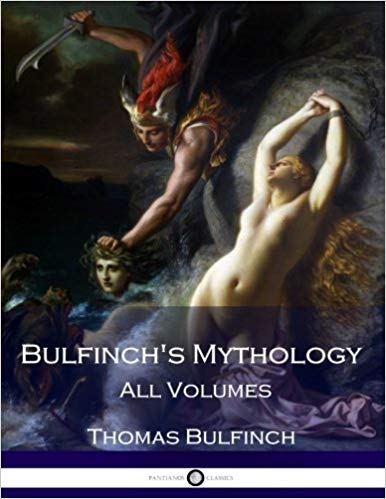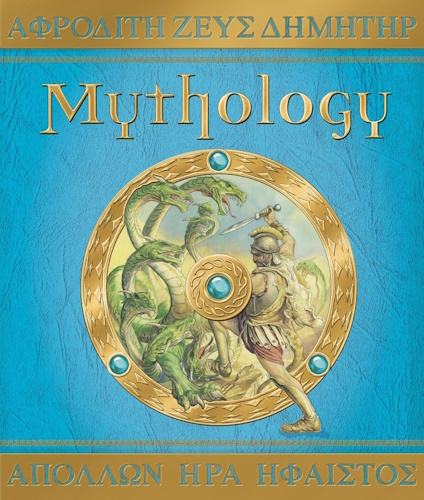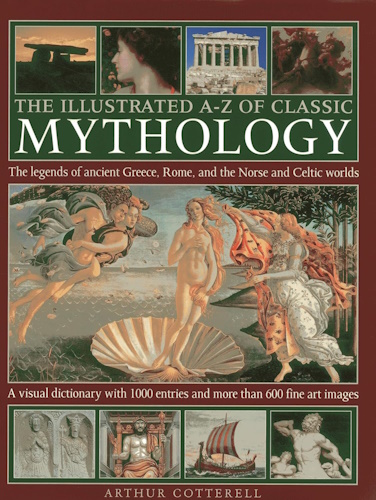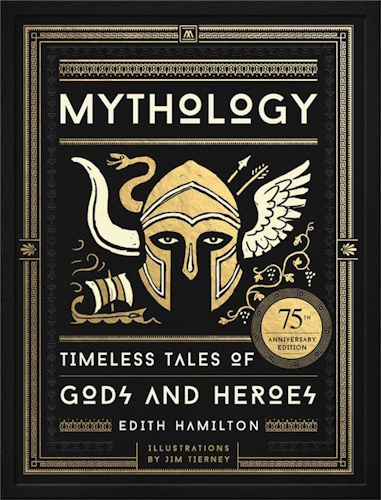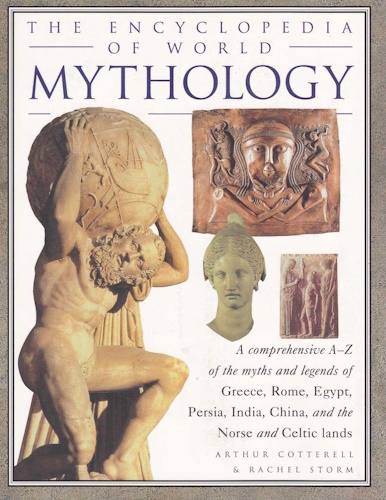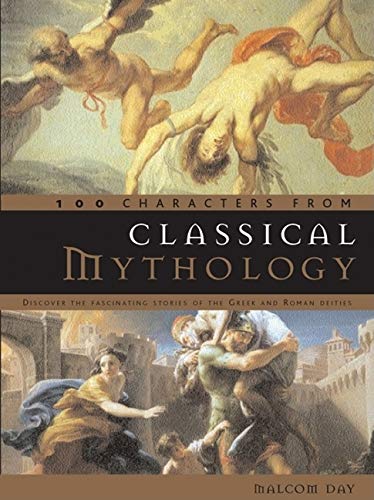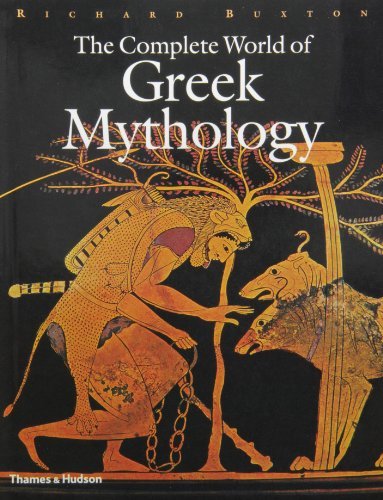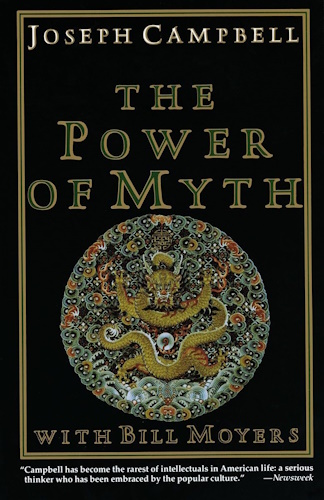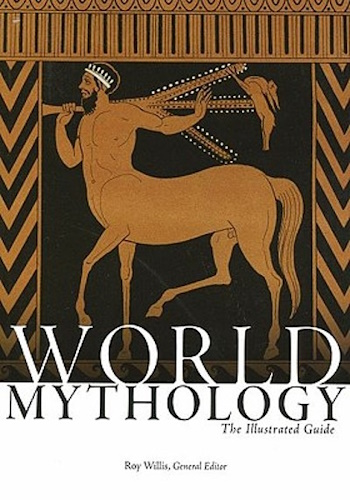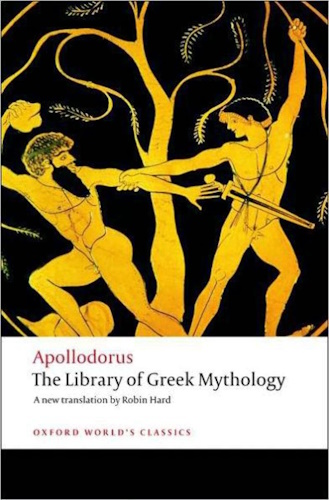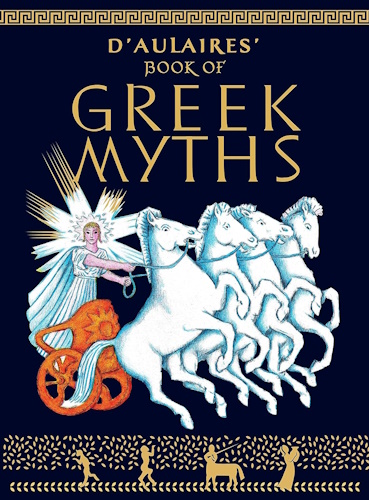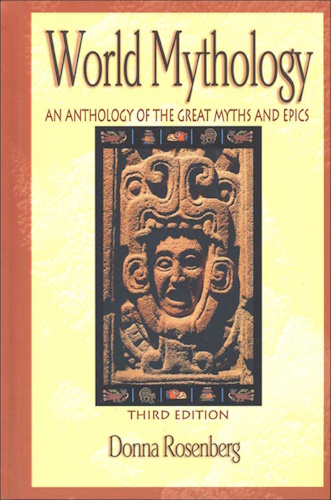
![]()
![]()
Part I.
King Arthur and His Knights.
Chapter X.
The Story of Tristram of Lyonesse.
MELIADUS was king of Leonois, or Lyonesse, a country famous in the annals of romance, which adjoined the kingdom of Cornwall, but has now disappeared from the map, having been, it is said, overwhelmed by the ocean. Meliadus was married to Isabella, sister of Mark, king of Cornwall. A fairy fell in love with him, and drew him away by enchantment while he was engaged in hunting. His queen set out in quest of him, but was taken ill on her journey, and died, leaving an infant son, whom, from the melancholy circumstances of his birth, she called Tristram.
Gouvernail, the queen's squire, who had accompanied her, took charge of the child, and restored him to his father, who had at length burst the enchantments of the fairy, and returned home.
Meliadus, after seven years, married again, and the new queen, being jealous of the influence of Tristram with his father, laid plots for his life, which were discovered by Gouvernail, who, in consequence, fled with the boy to the court of the king of France, where Tristram was kindly received, and grew up improving in every gallant and knightly accomplishment, adding to his skill in arms the arts of music and of chess. In particular, he devoted himself to the chase and to all woodland sports, so that he became distinguished above all other chevaliers of the court for his knowledge of all that relates to hunting. No wonder that Belinda, the king's daughter, fell in love with him; but as he did not return her passion, she, in a sudden impulse of anger, excited her father against him, and he was banished the kingdom. The princess soon repented of her act, and in despair destroyed herself, having first written a most tender letter to Tristram, sending him at the same time a beautiful and sagacious dog, of which she was very fond, desiring him to keep it as a memorial of her. Meliadus was now dead, and as his queen, Tristram's stepmother, held the throne, Gouvernail was afraid to carry his pupil to his native country, and took him to Cornwall, to his uncle Mark, who gave him a kind reception.
King Mark resided at the castle of Tintadel, already mentioned in the history of Uther and Iguerne. In this court Tristram became distinguished in all the exercises incumbent on a knight; nor was it long before he had an opportunity of practically employing his valor and skill. Moraunt, a celebrated champion, brother to the queen of Ireland, arrived at the court, to demand tribute of King Mark. The knights of Cornwall are in ill repute, in romance, for their cowardice and they exhibited it on this occasion. King Mark could find no champion who dared to encounter the Irish knight, till his nephew Tristram, who had not yet received the honors of knighthood, craved to be admitted to the order, offering at the same time to fight the battle of Cornwall against the Irish champion. King Mark assented with reluctance; Tristram received the accolade, which conferred knighthood upon him; and the place and time were assigned for the encounter.
Without attempting to give the details of this famous combat, the first and one of the most glorious of Tristram's exploits, we shall only say that the young knight, though severely wounded, cleft the head of Moraunt, leaving a portion of his sword in the wound. Moraunt, half dead with his wound and the disgrace of his defeat, hastened to hide himself in his ship, sailed away with all speed for Ireland, and died soon after arriving in his own country.
The kingdom of Cornwall was thus delivered from its tribute. Tristram, weakened by loss of blood, fell senseless. His friends flew to his assistance. They dressed his wounds, which in general healed readily; but the lance of Moraunt was poisoned, and one wound which it made yielded to no remedies, but grew worse day by day. The surgeons could do no more. Tristram asked permission of his uncle to depart, and seek for aid in the kingdom of Loegria (England). With his consent he embarked, and, after tossing for many days on the sea, was driven by the winds to the coast of Ireland. He landed, full of joy and gratitude that he had escaped the peril of the sea; took his rote,11 and began to play. It was a summer evening, and the king of Ireland and his daughter, the beautiful Isoude, were at a window which overlooked the sea. The strange harper was sent for, and conveyed to the palace, where, finding that he was in Ireland, whose champion he had lately slain, he concealed his name, and called himself Tramtris. The queen undertook his cure, and by a medicated bath gradually restored him to health. His skill in music and in games occasioned his being frequently called to court, and he became instructor of the Princess Isoude in minstrelsy and poetry, who profited so well under his care, that she soon had no equal in the kingdom, except her instructor.
11 A musical instrument.
At this time a tournament was held, at which many knights of the Round Table, and others, were present. On the first day a Saracen prince, named Palamedes, obtained the advantage over all. They brought him to the court, and gave him a feast, at which Tristram, just recovering from his wound, was present. The fair Isoude appeared on this occasion in all her charms. Palamedes could not behold them without emotion, and made no effort to conceal his love. Tristram perceived it, and the pain he felt from jealousy taught him how dear the fair Isoude had already become to him.
Next day the tournament was renewed. Tristram, still feeble from his wound, rose during the night, took his arms, and concealed them in a forest near the place of the contest, and, after it had begun, mingled with the combatants. He overthrew all that encountered him, in particular Palamedes, whom he brought to the ground with a stroke of his lance, and then fought him hand to hand, bearing off the prize of the tourney. But his exertions caused his wound to reopen; he bled fast, and in this sad state, yet in triumph, they bore him to the palace. The fair Isoude devoted herself to his relief with an interest which grew more vivid day by day; and her skilful care soon restored him to health.
It happened one day that a damsel of the court, entering the closet where Tristram's arms were deposited, perceived that a part of the sword had been broken off. It occurred to her that the missing portion was like that which was left in the skull of Moraunt, the Irish champion. She imparted her thought to the queen, who compared the fragment taken from her brother's wound with the sword of Tristram, and was satisfied that it was part of the same, and that the weapon of Tristram was that which reft her brother's life. She laid her griefs and resentment before the king, who satisfied himself with his own eyes of the truth of her suspicions. Tristram was cited before the whole court, and reproached with having dared to present himself before them after having slain their kinsman. He acknowledged that he had fought with Moraunt to settle the claim for tribute, and said that it was by force of winds and waves alone that he was thrown on their coast. The queen demanded vengeance for the death of her brother; the fair Isoude trembled and grew pale, but a murmur rose from all the assembly that the life of one so handsome and so brave should not be taken for such a cause, and generosity finally triumphed over resentment in the mind of the king. Tristram was dismissed in safety, but commanded to leave the kingdom without delay, and never to return thither under pain of death. Tristram went back, with restored health, to Cornwall.
King Mark made his nephew give him a minute recital of his adventures. Tristram told him all minutely; but when he came to speak of the fair Isoude, he described her charms with a warmth and energy such as none but a lover could display. King Mark was fascinated with the description, and, choosing a favorable time, demanded a boon12 of his nephew, who readily granted it. The king made him swear upon the holy reliques that he would fulfil his commands. Then Mark directed him to go to Ireland, and obtain for him the fair Isoude to be queen of Cornwall.
12 "Good faith was the very corner-stone of chivalry. Whenever a knight's word was pledged (it mattered not how rashly), it was to be redeemed at any price. Hence the sacred obligation of the boon granted by a knight to his suppliant. Instances without number occur in romance, in which a knight, by rashly granting an indefinite boon, was obliged to do or suffer something extremely to his prejudice. But it is not in romance alone that we find such singular instances of adherence to an indefinite promise. The history of the times presents authentic transactions equally embarrassing and absurd."– SCOTT, note of Sir Tristram.
Tristram believed it was certain death for him to return to Ireland; and how could he act as ambassador for his uncle in such a cause? Yet, bound by his oath, he hesitated not for an instant. He only took the precaution to change his armor. He embarked for Ireland; but a tempest drove him to the coast of England, near Camelot, where King Arthur was holding his court, attended by the knights of the Round Table, and many others, the most illustrious in the world.
Tristram kept himself unknown. He took part in many jousts; he fought many combats, in which he covered himself with glory. One day he saw among those recently arrived the king of Ireland, father of the fair Isoude. This prince, accused of treason against his liege sovereign, Arthur, came to Camelot to free himself of the charge. Blaanor, one of the most redoubtable warriors of the Round Table, was his accuser, and Argius, the king, had neither youthful vigor nor strength to encounter him. He must therefore seek a champion to sustain his innocence. But the knights of the Round Table were not at liberty to fight against one another, unless in a quarrel of their own. Argius heard of the great renown of the unknown knight; he also was witness of his exploits. He sought him, and conjured him to adopt his defence, and on his oath declared that he was innocent of the crime of which he was accused. Tristram readily consented, and made himself known to the king, who on his part promised to reward his exertions, if successful, with whatever gift he might ask.
Tristram fought with Blaanor, and overthrew him, and held his life in his power. The fallen warrior called on him to use his right of conquest, and strike the fatal blow. "God forbid," said Tristram, "that I should take the life of so brave a knight!" He raised him up and restored him to his friends. The judges of the field decided that the king of Ireland was acquitted of the charge against him, and they led Tristram in triumph to his tent. King Argius, full of gratitude, conjured Tristram to accompany him to his kingdom. They departed together, and arrived in Ireland; and the queen, forgetting her resentment for her brother's death, exhibited to the preserver of her husband's life nothing but gratitude and good-will.
How happy a moment for Isoude, who knew that her father had promised his deliverer whatever boon he might ask. But the unhappy Tristram gazed on her with despair, at the thought of the cruel oath which bound him. His magnanimous soul subdued the force of his love. He revealed the oath which he had taken, and with trembling voice demanded the fair Isoude for his uncle.
Argius consented, and soon all was prepared for the departure of Isoude. Brengwain, her favorite maid-of-honor, was to accompany her. On the day of departure the queen took aside this devoted attendant, and told her that she had observed that her daughter and Tristram were attached to one another, and that to avert the bad effects of this inclination she had procured from a powerful fairy a potent philter (love-draught), which she directed Brengwain to administer to Isoude and to King Mark on the evening of their marriage.
Isoude and Tristram embarked together. A favorable wind filled the sails and promised them a fortunate voyage. The lovers gazed upon one another, and could not repress their sighs. Love seemed to light up all his fires on their lips, as in their hearts. The day was warm; they suffered from thirst. Isoude first complained. Tristram descried the bottle containing the love-draught, which Brengwain had been so imprudent as to leave in sight. He took it, gave some of it to the charming Isoude, and drank the remainder himself. The dog Houdain licked the cup. The ship arrived in Cornwall, and Isoude was married to King Mark. The old monarch was delighted with his bride, and his gratitude to Tristram was unbounded. He loaded him with honors, and made him chamberlain of his palace, thus giving him access to the queen at all times.
In the midst of the festivities of the court which followed the royal marriage, an unknown minstrel one day presented himself, bearing a harp of peculiar construction. He excited the curiosity of King Mark by refusing to play upon it till he should grant him a boon. The king having promised to grant his request, the minstrel, who was none other than the Saracen knight, Sir Palamedes, the lover of the fair Isoude, sung to the harp a lay, in which he demanded Isoude as the promised gift. King Mark could not by the laws of knighthood withhold the boon. The lady was mounted on her horse and led away by her triumphant lover. Tristram, it is needless to say, was absent at the time, and did not return until their departure. When he heard what had taken place, he seized his rote, and hastened to the shore, where Isoude and her new master had already embarked. Tristram played upon his rote, and the sound reached the ears of Isoude, who became so deeply affected that Sir Palamedes was induced to return with her to land, that they might see the unknown musician. Tristram watched his opportunity, seized the lady's horse by the bridle, and plunged with her into the forest, tauntingly informing his rival that "what he had got by the harp he had lost by the rote." Palamedes pursued, and a combat was about to commence, the result of which must have been fatal to one or other of these gallant knights; but Isoude stepped between them, and, addressing Palamedes, said, "You tell me that you love me; you will not then deny me the request I am about to make?" "Lady," he replied, "I will perform your bidding." "Leave, then," said she, "this contest, and repair to King Arthur's court, and salute Queen Guenever for me; tell her that there are in the world but two ladies, herself and I, and two lovers, hers and mine; and come thou not in future in any place where I am." Palamedes burst into tears. "Ah, lady," said he, "I will obey you; but I beseech you that you will not forever steel your heart against me." "Palamedes," she replied, "may I never taste of joy again if I ever quit my first love." Palamedes then went his way. The lovers remained a week in concealment, after which Tristram restored Isoude to her husband, advising him in future to reward minstrels in some other way.
The king showed much gratitude to Tristram, but in the bottom of his heart he cherished bitter jealousy of him. One day Tristram and Isoude were alone together in her private chamber. A base and cowardly knight of the court, named Audret, spied them through a keyhole. They sat at a table of chess, but were not attending to the game. Andret brought the king, having first raised his suspicions, and placed him so as to watch their motions. The king saw enough to confirm his suspicions, and he burst into the apartment with his sword drawn, and had nearly slain Tristram before he was put on his guard. But Tristram avoided the blow, drew his sword, and drove before him the cowardly monarch, chasing him through all the apartments of the palace, giving him frequent blows with the flat of his sword, while he cried in vain to his knights to save him. They were not inclined, or did not dare to interpose in his behalf.
A proof of the great popularity of the tale of Sir Tristram is the fact that the Italian poets, Boiardo and Ariosto, have founded upon it the idea of the two enchanted fountains, which produced the opposite effects of love and hatred. Boiardo thus describes the fountain of hatred:–
"Fair was that fountain, sculptured all of gold,
With alabaster sculptured, rich and rare;
And in its basin clear thou might'st behold
The flowery marge reflected fresh and fair.
Sage Merlin framed the font,- so legends bear,-
When on fair Isoude doated Tristram brave,
That the good errant knight, arriving there,
Might quaff oblivion in the enchanted wave,
And leave his luckless love, and ‘scape his timeless grave.
"But ne'er the warrior's evil fate allowed
His steps that fountain's charmed verge to gain,
Though restless, roving on adventure proud,
He traversed oft the land and oft the main."
. . . . . . . .
-
Urantia Book, 44:0.11 - The Celestial Artisans
Never in your long ascendancy will you lose the power to recognize your associates of former existences. Always, as you ascend inward in the scale of life, will you retain the ability to recognize and fraternize with the fellow beings of your previous and lower levels of experience. Each new translation or resurrection will add one more group of spirit beings to your vision range without in the least depriving you of the ability to recognize your friends and fellows of former estates.
-
Princess Bride 1987 Wallace Shawn (Vizzini) and Mandy Patinkin (Inigo Montoya)
Vizzini: HE DIDN'T FALL? INCONCEIVABLE.
Inigo Montoya: You keep using that word. I do not think it means what you think it means. -
Urantia Book, 117:4.14 - The Finite God
And here is mystery: The more closely man approaches God through love, the greater the reality -- actuality -- of that man. The more man withdraws from God, the more nearly he approaches nonreality -- cessation of existence. When man consecrates his will to the doing of the Father's will, when man gives God all that he has, then does God make that man more than he is.
-
Urantia Book, 167:7.4 - The Talk About Angels
"And do you not remember that I said to you once before that, if you had your spiritual eyes anointed, you would then see the heavens opened and behold the angels of God ascending and descending? It is by the ministry of the angels that one world may be kept in touch with other worlds, for have I not repeatedly told you that I have other sheep not of this fold?"
-
Urantia Book, Foreword - 0:12.12 - The Trinities
But we know that there dwells within the human mind a fragment of God, and that there sojourns with the human soul the Spirit of Truth; and we further know that these spirit forces conspire to enable material man to grasp the reality of spiritual values and to comprehend the philosophy of universe meanings. But even more certainly we know that these spirits of the Divine Presence are able to assist man in the spiritual appropriation of all truth contributory to the enhancement of the ever-progressing reality of personal religious experience—God-consciousness.
-
Urantia Book, 1:4.3 - The Mystery Of God
When you are through down here, when your course has been run in temporary form on earth, when your trial trip in the flesh is finished, when the dust that composes the mortal tabernacle "returns to the earth whence it came"; then, it is revealed, the indwelling "Spirit shall return to God who gave it." There sojourns within each moral being of this planet a fragment of God, a part and parcel of divinity. It is not yet yours by right of possession, but it is designedly intended to be one with you if you survive the mortal existence.
-
Urantia Book, 1:4.1 - The Mystery Of God
And the greatest of all the unfathomable mysteries of God is the phenomenon of the divine indwelling of mortal minds. The manner in which the Universal Father sojourns with the creatures of time is the most profound of all universe mysteries; the divine presence in the mind of man is the mystery of mysteries.
-
Urantia Book, 1:4.6 - The Mystery Of God
To every spirit being and to every mortal creature in every sphere and on every world of the universe of universes, the Universal Father reveals all of his gracious and divine self that can be discerned or comprehended by such spirit beings and by such mortal creatures. God is no respecter of persons, either spiritual or material. The divine presence which any child of the universe enjoys at any given moment is limited only by the capacity of such a creature to receive and to discern the spirit actualities of the supermaterial world.
-
Urantia Book, 11:0.1 - The Eternal Isle Of Paradise
Paradise is the eternal center of the universe of universes and the abiding place of the Universal Father, the Eternal Son, the Infinite Spirit, and their divine co-ordinates and associates. This central Isle is the most gigantic organized body of cosmic reality in all the master universe. Paradise is a material sphere as well as a spiritual abode. All of the intelligent creation of the Universal Father is domiciled on material abodes; hence must the absolute controlling center also be material, literal. And again it should be reiterated that spirit things and spiritual beings are real.
-
Urantia Book, 50:6.4 - Planetary Culture
Culture presupposes quality of mind; culture cannot be enhanced unless mind is elevated. Superior intellect will seek a noble culture and find some way to attain such a goal. Inferior minds will spurn the highest culture even when presented to them ready-made.
-
Urantia Book, 54:1.6 - True And False Liberty
True liberty is the associate of genuine self-respect; false liberty is the consort of self-admiration. True liberty is the fruit of self-control; false liberty, the assumption of self-assertion. Self-control leads to altruistic service; self-admiration tends towards the exploitation of others for the selfish aggrandizement of such a mistaken individual as is willing to sacrifice righteous attainment for the sake of possessing unjust power over his fellow beings.
-
Urantia Book, 54:1.9 - True And False Liberty
How dare the self-willed creature encroach upon the rights of his fellows in the name of personal liberty when the Supreme Rulers of the universe stand back in merciful respect for these prerogatives of will and potentials of personality! No being, in the exercise of his supposed personal liberty, has a right to deprive any other being of those privileges of existence conferred by the Creators and duly respected by all their loyal associates, subordinates, and subjects.
-
Urantia Book, 54:1.8 - True And False Liberty
There is no error greater than that species of self-deception which leads intelligent beings to crave the exercise of power over other beings for the purpose of depriving these persons of their natural liberties. The golden rule of human fairness cries out against all such fraud, unfairness, selfishness, and unrighteousness.
